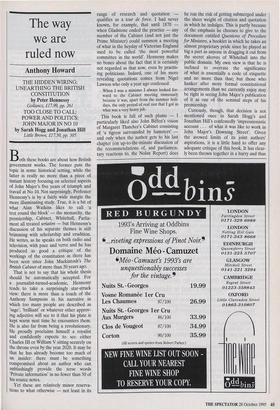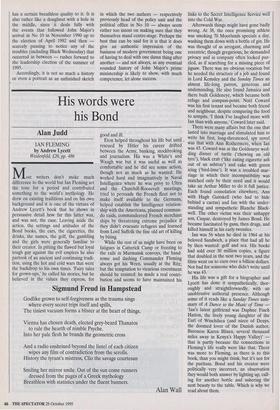The way we are ruled now
Anthony Howard
THE HIDDEN WIRING: UNEARTHING THE BRITISH CONSTITUTION by Peter Hennessy Gollancz, £17.99, pp. 261 TOO CLOSE TO CALL: POWER AND POLITICS: JOHN MAJOR IN NO 10 by Sarah Hogg and Jonathan Hill Little Brown, £17.50, pp. 305 Both these books are about how British government works. The former puts the topic in some historical setting, while the latter is really no more than a piece of instant history focusing on selected aspects of John Major's five years of triumph and travail at No 10. Not surprisingly, Professor Hennessy's is by a fairly wide margin the more illuminating study. True, it is a bit of what Alan Watkins likes to call 'a trot round the block' — the monarchy, the premiership, Cabinet, Whitehall, Parlia- ment all treated seriatim — but Hennessy's discussion of his separate themes is still brimming with scholarship and erudition. He writes, as he speaks on both radio and television, with pace and verve and he has produced as good a critique of the workings of the constitution as there has been seen since John Mackintosh's The British Cabinet of more than 30 years ago.
That is not to say that his whole thesis should be automatically accepted. For a journalist-turned-academic, Hennessy tends to take a surprisingly star-struck view: there is more than a touch of the Anthony Sampsons in his narrative in which too many people are described as `sage', 'brilliant' or whatever other approv- ing adjective will see to it that his plate is kept warm next time he encounters them. He is also far from being a revolutionary. He proudly proclaims himself a royalist and confidently expects to see either Charles III or William V sitting securely on the throne even by the year 2020. It may be that he has already become too much of an insider: there must be something compromised about an author who can unblushingly provide the terse words `Private information' in no fewer than 50 of his source notes.
Yet these are relatively minor reserva- tions to what otherwise — not least in its range of research and quotation qualifies as a tour de force. I had never known, for example, that until 1870 when Gladstone ended the practice — any member of the Cabinet (and not just the Prime Minister) could summon a meeting of what in the heyday of Victorian England used to be called 'the most powerful committee in the world'. Hennessy makes no bones about the fact that it is certainly not regarded as that now, even by practis- ing politicians. Indeed, one of his more revealing quotations comes from Nigel Lawson who only a year ago confessed: When I was a minister I always looked for- ward to the Cabinet meeting immensely because it was, apart from the summer holi- days, the only period of real rest that I got in what was a very heavy job.
This book is full of such plums — I particularly liked also John Biffen's vision of Margaret Thatcher's Cabinet consisting of 'a tigress surrounded by hamsters' and only when the author gets to his last chapter (on up-to-the-minute discussion of the recommendations of, and parliamen- tary reactions to, the Nolan Report) does he run the risk of getting submerged under the sheer weight of citation and quotation in which he indulges. This is partly because of the emphasis he chooses to give to the document entitled Questions of Procedure for Ministers, a booklet in which he takes an almost proprietary pride since he played as big a part as anyone in dragging it out from the secret alcoves of Whitehall into the public domain. My own view is that he is inclined to overrate the significance of what is essentially a code of etiquette and no more than that; but those who hanker after more formal constitutional arrangements than we currently enjoy may be right in seeing John Major's publication of it as one of the seminal steps of his premiership.
Curiously, though, that decision is not mentioned once in Sarah Hogg's and Jonathan Hill's confessedly 'impressionistic account . . . of what it was like to work in John Major's Downing Street'. Given the avowed limits of its joint authors' aspirations, it is a little hard to offer any adequate critique of this book. It has clear- ly been thrown together in a hurry and thus has a certain breathless quality to it. It is also rather like a doughnut with a hole in the middle, since it deals fully with the events that followed John Major's arrival in No 10 in November 1990 up to the election of April 1992 and then scarcely pausing to notice any of the troubles (including Black Wednesday) that occurred in between — rushes forward to the leadership election of the summer of 1995.
Accordingly, it is not so much a history or even a portrait as an unfinished sketch in which the two authors — respectively previously head of the policy unit and the political office in No 10 — always seem rather too intent on making sure that they themselves stand centre-stage. Perhaps the best that can be said for it is that it does give an authentic impression of the business of modern government being one of having to deal with one damn thing after another — and not always, as any eventual rounded history of John Major's prime ministership is likely to show, with much competence, let alone success.



































































 Previous page
Previous page